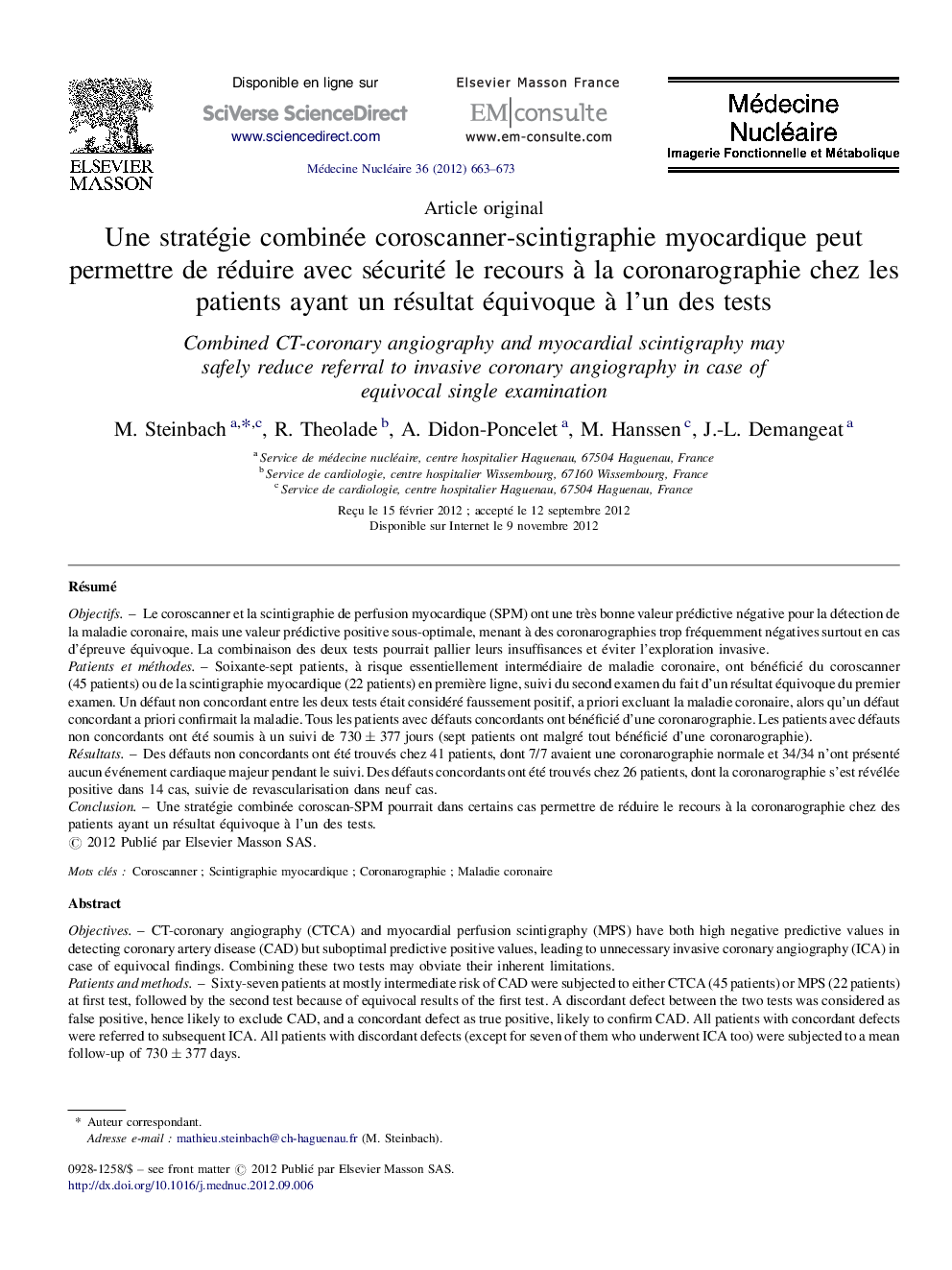| کد مقاله | کد نشریه | سال انتشار | مقاله انگلیسی | نسخه تمام متن |
|---|---|---|---|---|
| 4244324 | 1283385 | 2012 | 11 صفحه PDF | دانلود رایگان |

RésuméObjectifsLe coroscanner et la scintigraphie de perfusion myocardique (SPM) ont une très bonne valeur prédictive négative pour la détection de la maladie coronaire, mais une valeur prédictive positive sous-optimale, menant à des coronarographies trop fréquemment négatives surtout en cas d’épreuve équivoque. La combinaison des deux tests pourrait pallier leurs insuffisances et éviter l’exploration invasive.Patients et méthodesSoixante-sept patients, à risque essentiellement intermédiaire de maladie coronaire, ont bénéficié du coroscanner (45 patients) ou de la scintigraphie myocardique (22 patients) en première ligne, suivi du second examen du fait d’un résultat équivoque du premier examen. Un défaut non concordant entre les deux tests était considéré faussement positif, a priori excluant la maladie coronaire, alors qu’un défaut concordant a priori confirmait la maladie. Tous les patients avec défauts concordants ont bénéficié d’une coronarographie. Les patients avec défauts non concordants ont été soumis à un suivi de 730 ± 377 jours (sept patients ont malgré tout bénéficié d’une coronarographie).RésultatsDes défauts non concordants ont été trouvés chez 41 patients, dont 7/7 avaient une coronarographie normale et 34/34 n’ont présenté aucun événement cardiaque majeur pendant le suivi. Des défauts concordants ont été trouvés chez 26 patients, dont la coronarographie s’est révélée positive dans 14 cas, suivie de revascularisation dans neuf cas.ConclusionUne stratégie combinée coroscan-SPM pourrait dans certains cas permettre de réduire le recours à la coronarographie chez des patients ayant un résultat équivoque à l’un des tests.
ObjectivesCT-coronary angiography (CTCA) and myocardial perfusion scintigraphy (MPS) have both high negative predictive values in detecting coronary artery disease (CAD) but suboptimal predictive positive values, leading to unnecessary invasive coronary angiography (ICA) in case of equivocal findings. Combining these two tests may obviate their inherent limitations.Patients and methodsSixty-seven patients at mostly intermediate risk of CAD were subjected to either CTCA (45 patients) or MPS (22 patients) at first test, followed by the second test because of equivocal results of the first test. A discordant defect between the two tests was considered as false positive, hence likely to exclude CAD, and a concordant defect as true positive, likely to confirm CAD. All patients with concordant defects were referred to subsequent ICA. All patients with discordant defects (except for seven of them who underwent ICA too) were subjected to a mean follow-up of 730 ± 377 days.ResultsDiscordant findings between CTCA and MPS were found in 41 patients, from whose 7/7 had no significant stenosis at the invasive angiography and 34/34 had no major cardiac event during follow-up. Concordant findings were found in 26 patients. Invasive coronary angiography revealed significant stenoses in 14/26 patients; 9/14 of them needed revascularization.ConclusionA strategy combining CTCA and MPS may safely reduce referral to ICA in patients with equivocal findings at a single examination.
Journal: Médecine Nucléaire - Volume 36, Issue 11, November 2012, Pages 663–673